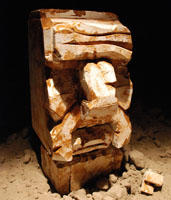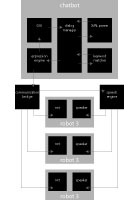DOI: 10.1145/1734454.1734572 | CITEULIKE: 6775814 | REFERENCE: BibTex, Endnote, RefMan | PDF ![]()
Schonenberg, B., & Bartneck, C. (2010). Mysterious Machines. Proceedings of the 5th ACM/IEEE International Conference on Human-Robot Interaction, Osaka pp. 349-350.
Mysterious Machines
Department of Industrial Design
Eindhoven University of Technology
Den Dolech 2, 5600MB Eindhoven, NL
w.a.s.schonenberg@student.tue.nl, christoph@bartneck.de
Abstract - Alan Turing proposed a test for the intelligence of machines in 1950 [1]. Despite great efforts, no computer has passed this test so far. Each year, chat bots compete for the Loebner Prize, the first formal instantiation of a Turing Test. No contender was able to fool the jury yet. Major problems of the chat bots are the lack of common knowledge and the logical consistency of a dialogue.
Keywords: turing;chatbot;exhibition;religion
Introduction
The conversational robots are part of an interactive installation. We will describe the three equally important aspects of the robots: the mechanical structure, the design of the appearance and the software architecture. The robots are intended to be placed is at art festivals or museums. The robots discuss their religious believes amongst each other and with the audience. Each robot represents one faith: Christianity, Islam and Hinduism. The scenario for the installation is the following: The robots are old and wise. They have been around since the original prophets walked the earth, and have been discussing their religious beliefs since then. Similar to other old ruins, these ancient stone statues endured the passing of time while the world around them had crumbled.
Installation Setup
The installation of the prototype consist of three robots. Because having only two robots would result in a rather predictable back and forth dialog, we added a third robot to have a more interesting flow of conversation. In this installation it is vital that the visitors can see and hear which robot is talking. The robots turn to the speaker and thereby focus the attention on him. Visitors can participate in the conversation by typing on a keyboard, and of course everyone can listen in to the conversation of the robots.
Robot
Hardware
The Lego NXT platform [2] is utilized for the prototyping since it is an excellent tool for prototyping robots [3]. It consists of a programmable brick, several sensors and actuators as well as numerous gears and mechanical parts. The exterior material for the robots is foam because its light weight does not stress the underlying Lego construction too much. The robots have two degrees of freedom: they can turn their heads left and right to be able to look at the speaker, and their jaw can move up and down to mimic lip movement while the robots are talking. In addition, we placed one speaker into each robot to playback their speech.
Appearance
The robots should attract the attention of the visitors of the exhibition and seduce them to approach the installation. From this requirement two important design decisions regarding what the robots have been made.
The first decision is whether or not the spectator should be able to see from the exterior of the robot what religion or conviction it represents. We decided not to reveal the robots conviction by avoiding stereotypical indicators, such as the christian robot wearing a cross. Visitors therefore have to listen to the conversation to make up their minds. Their judgement will be based on the utterances of the robots and not on the superficial knowledge and preconceptions. In addition, it challenges the visitors to guess which faith each robots represent.
We made an aesthetic decision to give the robots a wise and timeless look: old stone statues. We hope that this ancient appearance will lead visitors to believe that mystical utterances of the robots are deeply philosophical and not just odd. The inspiration for the style of the statues is based on ancient cultures: the Moai statues and Maya architecture.They should give the impression that they have been standing in the desert for eons. To keep them iconic, not too dusty, and not referencing one specific ancient style, we also took inspiration in contemporary pop culture [4]. Our aesthetic decisions resulted in the design of three robots of which one is visible in figure 1.
Figure 1. One robot from the installation.
Software
The chatbot system consists of several components and is visualized in figure 2. The XML parser imports text, such as the new testament or the koran into our system. The dialogue manager defines the turn taking of the robots and uses the keyword matcher to find appropriate sentences as replies to previous utterances. It then forwards the new sentence to the expression engine that manages the output modalities. The chatbot system use ActionScript and hence a communication bridge made in Java is necessary to communicate to the Lego NXTs using Bluetooth.
Figure 2. The software architecture
Conclusions
Impact of work
We hope that the peaceful conversation amongst the robots inspires an open dialogue amongst the religions. By focusing on a discussion of the original texts, we hope to emphasize our shared believes.
Future work
We intend to incorporate a speech recognition engine as a replacement for the text entry. It would allow users to match the communication modality of the robots and would thereby contribute to a more interactive installation. This can be achieved easily, but utilizing existing open source engines, such as Sphinx. We also did not yet have a chance to monitor the chat sessions of people using the installation. One could set up an experiment to ask people what they feel when they hear the conversation, and if the setup actually get them thinking more openly. A final step could be to conduct a formal Turing test that focuses on mystical topics.
References
- A. Turing, “Computing machinery and intelligence,” Mind, vol. 59, no. 236, pp. 433–460, 1950.
- LEGO, “nxt,” http://mindstorms.lego.com, 2009.
- C. Bartneck and J. Hu, “Rapid prototyping for interactive robots,” in Proceedings of the 8th Conference on Intelligent Autonomous Systems (IAS-8), 2004, pp. 136-145.
- J. Vandevelde, P Geurts, “Robbedoes en de vallei der bannelingen,” 1994.
This is a pre-print version | last updated March 8, 2010 | All Publications

